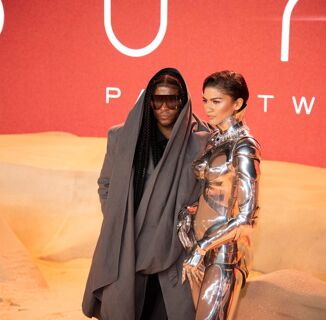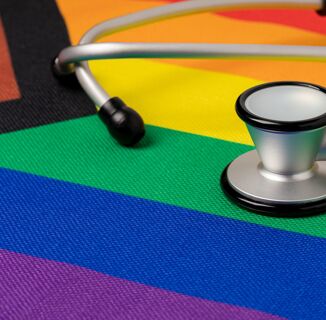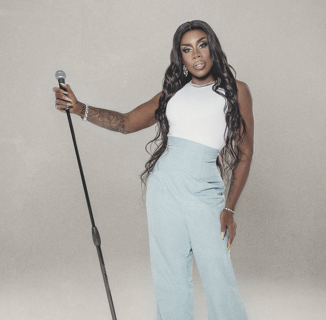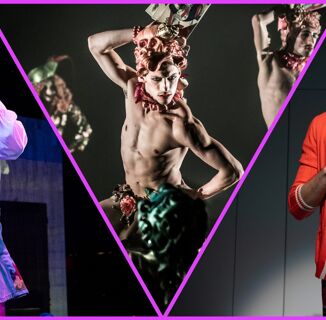A brand-new witch show called A Discovery of Witches debuted in the UK today and it stars Doctor Who’s Alex Kingston as a lesbian witch. Based on the Deborah Harkness trilogy All Souls, the new TV drama is the latest member to join an already burgeoning coven of gay witch content. It seems like in every on-screen coven, there’s a gay witch, or at the absolute least, super queer vibes swirling through the air, and that’s because witchcraft itself is inherently queer.

But why is that? Obviously, there’s nothing gayer than chanting with a glorified women’s group over a smoking cauldron of roots, but there’s more to it.
The most obvious answer to the age-old question of “Why is witchcraft lesbian?” is, of course: sisterhood. Sisterhood is the most basic and obligatory tenet of witchcraft, and as all women know, female relationships can often be intense, tangled, complicated and confusing. Many queer women first discover their sexuality by engaging in a boundless, toxic relationship with a best friend who asks you to sleep in the same bed every night and make out in front of boys so they won’t try and hit on you and tell you no one is good enough for you and tears your heart out of your chest and stomps on it until there’s nothing left but a pool of blood—not based on any sort of personal experience… Just what I’ve heard. So, to recap: sisterhood.
When you mix sisterhood with the second fundamental principle of witchcraft, which is secrecy, you’ve got the blueprints for a lesbian love affair. Covens are often veiled by an air of secrecy, because usually, discovering your powers is something you elect to keep to yourself until you feel safe exposing yourself to others, and the only other people you let into your circle are people who are just like you — an obvious allegory for coming out. Mixing the strength of sisterhood with the bond that shared secrets creates, and you’ve got the perfect storm for an intense girl-on-girl relationship — which obviously leads to the exiling of men.
Take Practical Magic (1998), for example. Maria Owens gets her heart broken by some flop man, who was probably incapable both physically and emotionally of caring for a fully realized witch TBH, and casts a spell on all future Owens women to prevent them from falling in love (with men). From that point forward, any man who falls for an Owen woman dies, and the only way they can seek love and intimacy and fulfillment is through their relationships with women. *Shouts like a dumb jock from the back of the classroom* GAYYYY!

Recently, The CW announced that the Charmed reboot would feature a lesbian Halliwell sister. And while we don’t know much about the character or how much her sexuality will play a part in her storyline, it makes sense. Along with Buffy The Vampire Slayer, the original Charmed was a female-fronted diamond in the rough amongst a slate of ’90s shows about men, which were marked by misogynistic writing and hollow female characters.
The sisters Halliwell were feminist icons, because, news flash: Witch shit is timeless. Women are always going to love secrets and hoarding power. And not for nothing, but the original Charmed starred Shannen Doherty, Alyssa Milano, Holly Marie Combs, and Rose McGowan, all of whom are bull-headed feminist activists today. *Whispers like Regina George at a sleepover* lesbian!
But let’s go back to Buffy. The late ’90s drama was a trailblazer for LGBTQ on-screen representation. Willow Rosenberg, played by Alyson Hannigan, was one of the first out lesbian protagonists on TV who was portrayed fairly, was bereft of negative stereotypes, and who was able to find love. And guess the fuck what? She was a witch! Case in point.

It’s also important to note the powers that witches often possess in movies and TV shows are also intrinsically queer. Willow, for example, came to learn about her powers late in life — god, becoming a witch is exactly like coming out, isn’t it? She did so by reading a bunch of crusty old books in the school library and electing to practice witchcraft via a few Pagan utterings. First off, sitting in the library is extremely lesbian, as is reading in general; more specifically, researching and obsessing over any topic is innately gay, and so is helping people. So, being a witch was pretty much written in the stars for Willow.
Other powers and witch-adjacent paraphernalia are extremely Sapphic too. Reading people’s minds? Rubbing orbs? Hovering?? CLOAKS?! Queer women are extraordinarily nosy and petty — we know this. Do you know how many of us would fucking kill to read the minds of the duplicitous women who ghosted us this summer but still haunt our Instagram stories and congratulate us on our recent accomplishments, completely unconcerned with the possibility that texting me about something unrelated to the time she hurt my feelings might subsequently read as insensitive? (Again, not my experience, just pulling from others). But seriously, all queer women do is wear black, tweet about our morbid, meaningless existence, rub each others’ orbs, and hover over our partners like a lingering, hostile helicopter.
It’s no wonder witches are always gay. As BuzzFeed’s Shannon Keating pointed out, the 1996 classic witch tale The Craft had extremely Sapphic undertones, especially when Nancy used her powers to co-opt her friend Sarah’s appearance in an attempt to sleep with Sarah’s ex-lover. So, did she want to be Sarah, or did she want to bone Sarah? Either way, using your already-queer powers to steal your female friend’s appearance is, ahem, gay as fuck. As is obsession. And revenge. And holding grudges. And Neve Campbell (OK, she’s not actually gay, but you’d believe it, right?)
Look, I can keep going. My natural born witch power is the ability to find gayness in anything and everything. But here are the facts: Salem had multiple queer witches, as did British 2000s show Hex. American Horror Story: Coven didn’t feature any queer characters, but Sarah Paulson played the rising Supreme (the strongest witch and coven leader) and is queer IRL. So many of these stories are about finding solace and connection in female partners. Often, these witches are cast out for being different (gay), can only trust each other with their deepest, darkest secrets (gay), and band together against men. *Yells out car window in a swell of road rage* GAY!
I don’t make the rules — I just report the cold, hard facts.
Help make sure LGBTQ+ stories are being told...
We can't rely on mainstream media to tell our stories. That's why we don't lock our articles behind a paywall. Will you support our mission with a contribution today?
Cancel anytime · Proudly LGBTQ+ owned and operated
Read More in Culture
The Latest on INTO
Subscribe to get a twice-weekly dose of queer news, updates, and insights from the INTO team.
in Your Inbox













